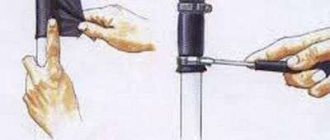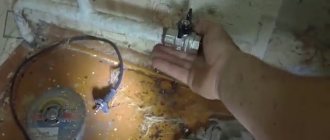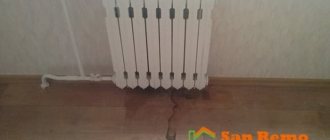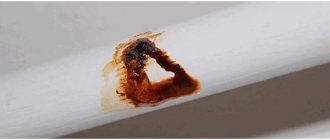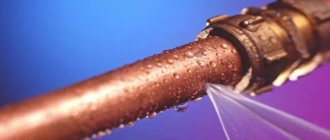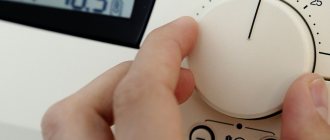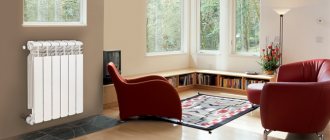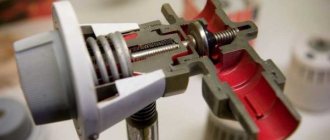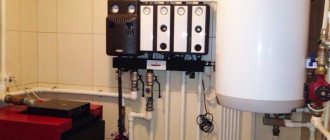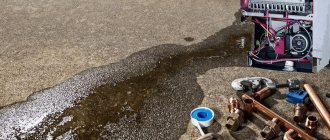How to detect a defective area
First, visually assess the condition of the battery. If it is old, worn out, with a lot of rusty spots that have already leaked, it is easier to buy and install a new one. If there are no obvious signs of wear, it is advisable to repair and restore it. Only defective items can be replaced.
Inspect everything carefully, paying attention to the joints, connections and the entrance area of the heating pipe. Hard-to-reach areas are inspected using a flashlight and mirror.
Sometimes the cause of poor or uneven heating is an air lock. To remove it, open the tap and drain a small amount of liquid. The airiness will disappear. If this does not happen, you need to look for damage.
If no defect is found, remove the housing and place it in a filled bath. Air bubbles will appear in areas of depressurization. After inspection, it will become clear what kind of damage occurred.
Repair of radiators that do not heat
The main reason for this situation is the presence of air inside the heating device or dirt that has accumulated on the internal walls. You can solve this problem like this:
- Bleed the air and check the further heating level.
- If the actions do not produce any result, then the battery must be removed and the level of contamination determined. The last step can be carried out by pouring water into the removed radiator, measuring the volume of liquid poured in and comparing it with the indicator specified in the technical documentation. If the difference is significant, then the radiator has a lot of dirt.
- If the degree of contamination is slight, you can try rinsing the battery with a very fast stream of water. Otherwise, you need to disassemble it into sections and wash each section. The section may need to be cleaned with a wire with a small, narrow brush attached to the end. It is desirable that the pile is not metallic, but is tough enough to remove dirt.
How to replace gaskets in case of leakage
The connections between the battery and the pipes, at the joints and between sections, are sealed with O-rings sealing the system. Most often they are made from paronite or other heat-resistant polymer. However, over time, this material wears out, becomes deformed, and coolant begins to leak through the worn ring. Sometimes the nipples connecting the parts of the unit are damaged.
The outer gasket is easy to replace. Turn off the supply tap, drain the water, unscrew the cap with a radiator wrench, remove the defective element and replace it with a new one.
It is more difficult to change sealing elements and nipples at intersectional joints. In this case, you will have to dismantle and disassemble sections with leaking joints. A radiator key is useful for this.
When disassembling, remember two subtleties:
- The thread can be either right-handed or left-handed, with equal probability. The products of many manufacturers are marked - right - D, and left - S.
- Each section is equipped with two heads. If you twist and move only one of them, distortion and deformation of the metal will occur. Therefore, loosen the fastenings parallel to the top and bottom, and move the disconnected elements strictly parallel.
Once you get to the damage, replace the torn O-ring or damaged nipple, and then put everything back in place.
Cellular repair
Repairing the aluminum honeycombs themselves always caused a severe headache for both car owners and craftsmen. The main reason is the sometimes very complex and almost unrepairable design, and the rather thin metal of the radiators, which do not have “weak points” in the design, so to speak. But let's consider everything in order.
Prefabricated radiators
The first type that we will describe is a prefabricated car radiator, which, as mentioned above, is inexpensive, but its high-quality repair requires quite large material investments, but at the same time it is quite possible with the hands of professionals. The design consists of a honeycomb part , which, by the way, if it breaks, it is not often; as a rule, the rubber seals are the first to fail.
Round honeycombs are fixed to the mesh using rolling, through a rubber seal, which is plastic at the beginning of its life. But this is only at first, and only when pouring high-quality antifreeze, then the gasket simply turns into a terrible sight. For example, the lifespan of a German radiator, which is operated with high-quality antifreeze, is approximately 11-16 years, a Soviet one - 7-11 years, a lifespan of modern and Chinese ones - can sometimes be from 20 minutes to several years .
If soldering the central part of this radiator (well, rubbed, or pierced with a screwdriver) is possible with the help of special solders, then it is beneficial and high-quality for both parties; repairing the “sinister connection” is almost impossible. Some workshops at one time developed a composition that makes it possible to solder aluminum honeycombs to a steel mesh, but, naturally, it is not practical to use it in repairing, for example, products for the VAZ-2107; this option is only good for repairing “foreign cars”.
How to fix housing leaks
When inspecting the metal, cracks and holes are often found that need to be repaired. In such cases, the battery will have to be removed and repaired.
Fix the defect in one of two ways:
- Cold – clean the area around the defect with sandpaper. To remove thick layers of rust and dirt, use soapy water or citric acid. Then seal the hole with high-temperature cold welding. In appearance it resembles plasticine, and after drying it forms a durable patch. You can use epoxy resin to which aluminum or bronze powder has been added; it seals holes in the metal well.
- Hot - the defect can be soldered with a soldering iron. A patch of flux, iron and rosin coated with solder will restore the seal. Please note that aluminum is difficult to solder without experience. The most effective hot method is argon welding, which provides reliable sealing of defects. In this case, you will have to contact specialists.
It is recommended to replace seals that have lost their strength and shape. This will allow you to avoid having to deal with dismantling and disassembling once again.
Is it possible to repair an aluminum radiator?
With all the variety of heating radiators, aluminum ones stand out for their very good performance, but they are not very popular among buyers. This is due to the properties of the material for the manufacture of aluminum radiators - repairing any part of the heating device if damaged causes a lot of problems, often requiring contact with specialists, or even replacing the battery. Many customers are firmly convinced that these radiators cannot be repaired at all, and they need to be replaced immediately. And due to the relative softness of aluminum, they are very easy to damage.
- Advantages and disadvantages of aluminum radiators
- Disadvantages of devices
- Steps to remove batteries for maintenance
- Types of repairs and their features
- Conclusion
During the coldest time of the year, the heating battery leaked.
An unpleasant situation, but quite common. And the most common cause of such breakdowns is metal corrosion, which results in the formation of fistulas. Sometimes a leak in the heating system appears due to improper installation, mechanical damage or excessive load. What to do in this situation? How to quickly solve the problem without having to replace the radiator. This trouble can be solved in a matter of minutes by covering the fistula with cold welding. But, unfortunately, this measure is temporary, and major repairs cannot be avoided in the future. This express method will help restore the battery's seal to 100%. Why shouldn’t you solve the problem with a jar or basin under a dripping radiator or pipe? The consequences can be very sad - a rupture of the radiator, a gushing hot water fountain, expensive repairs for the neighbors below at the expense of the hero of the occasion. Don't take the risk! It is urgent to fix the leak, and in the summer it is better to change the battery. In a private home, it is advisable to regularly carry out preventative maintenance on the autonomous water heating system in order to avoid such troubles in winter.
1. A small fistula can be quickly covered by cold welding yourself. And you can easily find cold welding in a plumbing store, an auto store, or any construction store. Before purchasing, do not forget to look at the manufacturing date on the back of the insert, since the shelf life of such a miracle glue is limited, and if you use an expired putty, you will be very disappointed - this glue tends to dry out while still in the package.
2.Where to start? First you need to find the exact location of the leak and determine the size of the fistula; perhaps there is more than one. The fistula may be hidden under swollen paint on an aluminum radiator. If the fistula has formed in such a place that it is difficult to get to it, then you may have to remove the modern heating radiator from its mounts and drain the water from it.
Most often, the radiator does not need to be removed - the fistula is in a place accessible for repair. And yet, before covering up the fistula, many plumbers advise turning off the water supply taps on it and opening the Mayevsky tap to drain the water from the battery, placing a bucket under the stream of water. Other experts say that this is not necessary, cold welding will perform its task well - it is not afraid of moisture.
3.But the swollen paint will have to be scraped off. This can be done using a knife, metal spatula or flat-head screwdriver. Under the paint you will probably see a small hole, or even two, maybe three.
4. Before you start gluing, it is advisable to sand and degrease the surface around the fistula. To do this, you can use sandpaper and alcohol or acetone.
5.Cut off the piece of cold welding required for repair. Mix all its components thoroughly with wet hands (wear gloves) until a homogeneous mass is obtained. The glue should warm up in your hands and become elastic and sticky.
6.Quickly apply putty to problem areas, and then again press the weld firmly with something hard, for example, a knife or screwdriver, to the surface of the radiator or pipe. If the surface is wet, it is necessary to press and smooth the adhesive until there is a feeling of sticking to the surface and the flow stops. You can hold the composition with a tourniquet for 15-20 minutes until it hardens completely.
Causes of holes and leaks
- Incorrect choice of heating system components and disruption of the installation process. Sometimes such errors emerge only during operation.
- External corrosion of the housing, which occurs from the outside with high humidity in the room. This often happens in bathrooms and showers.
- Incorrect physical and chemical parameters of the coolant that reacts with the metal. The aluminum or silumin body is destroyed.
- Draining the media for a long time - air accumulates inside the case, reacting with metals and alloys.
- Destruction of gaskets - the material from which they are made loses strength over time and does not seal.
- Damage to shut-off valves. Reasons: pressure surges, resource depletion.
What does the battery consist of?
If we are talking about old-type radiators, then in appearance they resemble accordions, while modern models are flat, due to which they heat up more evenly. Cast iron is a very strong material, but even it is not eternal, it has a limit of stability.
So the service life varies from 20 to 30 years, depending on operating conditions. If maintenance is carried out in a timely manner, the service life increases several times and the battery will last almost a hundred years.
Placing a basin or saucepan under a dripping radiator is not a solution, as the crack tends to grow, so that one day a flood may occur! If we are talking about the winter period, then there is generally boiling water in the pipes, which poses a serious danger to the life and health of people.
Useful tips
In order not to engage in restoration, you need to buy only high-quality radiators, and trust the installation of the heating system to trusted companies. You should not skimp on quality - constant repairs will cost more.
In order for the purchased product to serve for a long time, it should be used correctly - do not leave the heating system empty for a long time, fill only with a suitable coolant.
When repairing radiators, it is necessary to check the integrity of all elements. Perhaps there are still areas on the body that need to be restored, require replacement, or the shut-off valves or nipples are worn out.
Leak test
The quality of the repair can be checked using air or water pumped into the radiator under pressure. The air method has been previously described.
Pressurized water can only be checked during the heating season. To do this, a plug is placed on one side of the battery, and the other is connected to the supply through the Mayevsky tap. Having slightly unscrewed the tap and bypass, fill the radiator with water. To facilitate observations, a strip of white paper is placed under the battery.
If after 10-15 minutes the paper remains dry, the leak has been eliminated and the radiator can be connected to the general system.
If it is not possible to create pressure, then fill the radiator with colored water and leave it for several hours. Usually after 3-4 hours the leak manifests itself.
Use of iron rosin flux
There is a simple way to solder a radiator with a soldering iron using rosin-based flux. To do this, the damaged metal is prepared according to the following scheme:
- remove paint residues and all kinds of dirt;
- thoroughly clean the metal with an abrasive;
- degreased with a special solvent.
The preparation must be very conscientious; the entire repair depends on this. Flux is prepared in a metal crucible. Melt the rosin and gradually add iron filings there in a ratio of 1:2. Stir until smooth. Sawdust in this case will be an abrasive.
Next, the surface to be repaired is covered with a thin film of molten flux. The quality of future soldering depends on the thoroughness of the procedure. In this way, aluminum is protected from oxidation.
The materials used in the work emit toxins. Therefore, you need to do everything under a hood, or carry out repairs in a thoroughly ventilated area. If conditions permit, outdoors.
Next, the soldering process begins. Use a soldering iron to grab a little solder and apply it on top of the flux using smooth circular movements. This should be done slowly, carefully ensuring that the solder is evenly distributed over the damaged area.
How does flux behave in this case? Iron filings clean off oxides, and rosin blocks air access to aluminum. The conditions for contact between metals are met.
This method works when you need to solve the problem of how to solder an aluminum radiator if the damage is not great. Large areas cannot be repaired this way. The flux becomes cold very quickly, so soldering a large surface will be problematic.
Recommendations - where to call if a pipe burst in your apartment
Emergency situations usually arise unexpectedly, so information about where to call if a pipe has burst should be in a visible place: in the apartment or on your mobile phone.
Any person develops an algorithm of actions in critical conditions - he is directed towards a specific goal and consistently achieves it.
The direction is clear: stop the flow, and establishing who is to blame will not be difficult. Emergency phone It is important to know where to call if there is a water leak. The purpose of the telephone call is to notify the emergency repair team of an accident as soon as possible.
Such units are organized in all housing management companies and city utilities.
An accident occurs at any time of the day or night, and therefore available for contact
We recommend reading: How the market value of a land plot is determined
Why is it difficult to eliminate defects in aluminum?
Aluminum is the third most common chemical element on our planet and combines a lot of excellent qualities: strength and good thermal conductivity with a very low mass. It is indispensable when it is necessary to produce a product of a large area with intense heat transfer.
However, for all its undeniable advantages, aluminum has a big disadvantage - it is difficult to repair. Therefore, soldering an aluminum car radiator or heating system becomes a big problem.
The fact is that this metal is chemically active. High resistance to corrosion is ensured by a durable oxide film that protects aluminum from atmospheric influences.
It is this film that disrupts the soldering process. To achieve a metal-to-metal bond, you need to heat it. In this case, a layer of oxides is necessarily formed, which will prevent contact. The task of the master, when the question arises of how to solder an aluminum radiator, is to break this circle.
By the way, in the case of copper the same principle applies. Copper products are valued precisely because of their resistance to rust, but their unique ability to protect themselves from corrosion turns into a problem during repairs.
